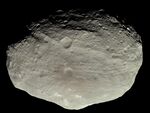Astronomy:GRB 110328A
| Duration | months, perhaps a year[1] |
|---|---|
| Right ascension | 16h 44m 49.97s |
| Declination | +57° 34′ 59.7″[2] |
| Total energy output | 5×1048 ergs (assuming beamed emission) |
Swift J164449.3+573451, initially referred to as GRB 110328A, and sometimes abbreviated to Sw J1644+57, was a tidal disruption event, the destruction of a star by a supermassive black hole. It was first detected by the Swift Gamma-Ray Burst Mission on March 28, 2011.[3] The event occurred in the center of a small galaxy in the Draco constellation, about 3.8 billion light-years away.[4]
Studied by dozens of telescopes, it is one of the most puzzling cosmic blasts of high-energy radiation ever observed when it comes to brightness, variability and durability.[5] It probably occurred when a star wandered too close to the central black hole in the galaxy, and was gravitationally torn apart and swallowed by it.[3][6][7][8] Timing considerations suggest that the tidally disrupted star was a white dwarf and not a regular main sequence star.[9]
Debris now encircles the black hole in an accretion disk, which launches bipolar jets at near the speed of light. Jet plasma emits the γ- and X-rays. The beam of radiation from one of these jets points directly toward Earth, enhancing the apparent brightness. Repetitive dimming and softening of the X-rays implies that the jet temporarily tilts away from us, due to precession of the warped disk.[10]
The jets drive shocks into the surrounding interstellar medium, resulting in a radio to infrared afterglow. Detection of the relativistically expanding afterglow confirmed the identity of the host galaxy.[11] Observed linear polarization of the infrared radiation is consistent with synchrotron emission from the afterglow shock.[12]
"This is truly different from any explosive event we have seen before," said Joshua Bloom of the University of California at Berkeley, the lead author of the study published in the June 2011 issue of Science.[8][13]
See also
References
- ↑ "Gamma-ray flash came from star being eaten by massive black hole". e! Science News. 2011-06-16. http://esciencenews.com/articles/2011/06/16/gamma.ray.flash.came.star.being.eaten.massive.black.hole.
- ↑ "NASA Telescopes Join Forces to Observe Unprecedented Explosion". Chandra Press Release: 7. 2011. Bibcode: 2011cxo..pres....7.. http://hubblesite.org/newscenter/archive/releases/2011/10/fastfacts/. Retrieved 2011-04-21.
- ↑ 3.0 3.1 Joshua S. Bloom (2011-03-30). "GRB 110328A / Swift J164449.3+573451: X-ray analysis and a mini-blazar analogy". GRB Coordinates Network 11847: 1. Bibcode: 2011GCN.11847....1B. http://gcn.gsfc.nasa.gov/gcn3/11847.gcn3.
- ↑ "GRB 110328A: Chandra Observes Extraordinary Event". Harvard-Smithsonian Center for Astrophysics. http://chandra.harvard.edu/photo/2011/grb110328/.
- ↑ "NASA Telescopes Join Forces to Observe Unprecedented Explosion". Chandra Press Release: 7. 2011-04-07. Bibcode: 2011cxo..pres....7.. http://www.nasa.gov/topics/universe/features/star-disintegration.html. Retrieved 2011-04-22.
- ↑ Barres de Almeida; De Angelis (2011-04-13). "Enhanced emission from GRB 110328A could be evidence for tidal disruption of a star". arXiv:1104.2528 [astro-ph.HE].
- ↑ Coco, Alejandro (2011-04-10). "The Most Intense Cosmic Explosion Ever Seen". Scienceray. http://scienceray.com/physics/the-most-intense-cosmic-explosion-ever-seen/.
- ↑ 8.0 8.1 Bloom, Joshua S.; Giannios, Dimitrios; Metzger, Brian D.; Cenko, S. Bradley; Perley, Daniel A.; Butler, Nathaniel R.; Tanvir, Nial R.; Levan, Andrew J. et al. (2011). "A Possible Relativistic Jetted Outburst from a Massive Black Hole Fed by a Tidally Disrupted Star". Science 333 (6039): 203–6. doi:10.1126/science.1207150. PMID 21680812. Bibcode: 2011Sci...333..203B.
- ↑ Krolik J.; Piran T. (2011-04-13). "Swift J1644+57: A White Dwarf Tidally Disrupted by a 10^4 M_{odot} Black Hole?". The Astrophysical Journal 743 (2): 134. doi:10.1088/0004-637X/743/2/134. Bibcode: 2011ApJ...743..134K.
- ↑ Saxton, C. J.; Soria, R.; Wu, K.; Kuin, N. P. M. (2012-01-25). "Long-term X-ray variability of Swift J1644+57". Monthly Notices of the Royal Astronomical Society 422 (2): 1625. doi:10.1111/j.1365-2966.2012.20739.x. Bibcode: 2012MNRAS.422.1625S.
- ↑ "Birth of a relativistic outflow in the unusual γ-ray transient Swift J164449.3+573451". Nature 476 (7361): 425–428. 2011. doi:10.1038/nature10366. PMID 21866155. Bibcode: 2011Natur.476..425Z.
- ↑ Wiersema, K.; van der Horst, A. J.; Levan, A. J.; Tanvir, N. R.; Karjalainen, R.; Kamble, A.; Kouveliotou, C.; Metzger, B. D. et al. (2011-12-13). "Polarimetry of the transient relativistic jet of GRB 110328 / Swift J164449.3+573451". Monthly Notices of the Royal Astronomical Society 421 (3): 1942–1948. doi:10.1111/j.1365-2966.2011.20379.x. Bibcode: 2012MNRAS.421.1942W.
- ↑ "Black hole eats star, triggers gamma-ray flash". Cosmos. June 17, 2011. http://www.cosmosmagazine.com/news/4428/black-hole-eats-star-produce-gamma-ray-flash.
Coordinates: ![]() 16h 44m 49.97s, +57° 34′ 59.7″
16h 44m 49.97s, +57° 34′ 59.7″
 |




